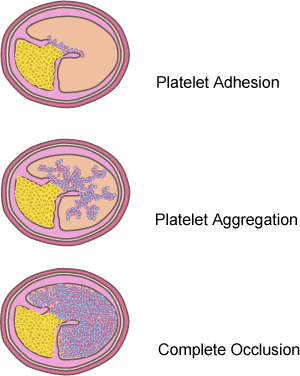Cardiology Teaching Package
A Beginners Guide to Normal Heart Function, Sinus Rhythm & Common Cardiac Arrhythmias
Platelet Aggregation
When a plaque inside a coronary artery ruptures, the process of platelet aggregation, linked to the creation of "fibrin", can cause a partial or complete occlusion of the artery. (see flow chart to come on Thrombosis).
Platelets, in their normal state, float around in the blood like smarties: nice and smooth and oval shaped. It is only when platelets receive biochemical signals that they start to react and, when an arterial plaque is ruptured, it releases these biochemical signals.
Platelets have receptor sites that await these messages. (like a postbox awaiting a specific letter to be delivered.) When platelets receive the correct biochemical message they begin to react. They become sticky and develop tentacles and start to roam around in gangs (platelet aggregation) and quickly make their way to the damaged area and pile on. (Imagine you are watching a football match and one team scores. All the players run to the scorer and pile on in one big heap.) This is what platelets do in the coronary artery, but without a referee to blow the whistle they keep on piling on until either they completely occlude the artery or cease to receive anymore biochemical messages when only partial occlusion has occurred.
Image: Thrombus Formation

If this process is not interrupted by medical intervention, the artery completely occludes (see above), and any tissue beyond the clot will begin to die within 30 minutes of rupture. However, the process of tissue death is not instant and can take up to 12 hours, although most of the damage will be complete within 6 hours.
